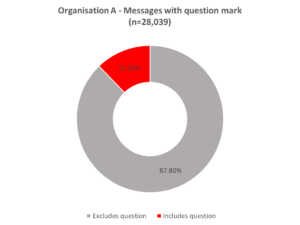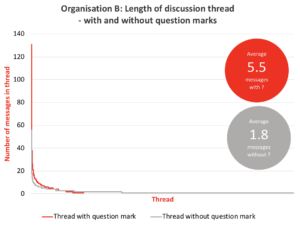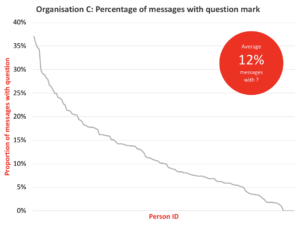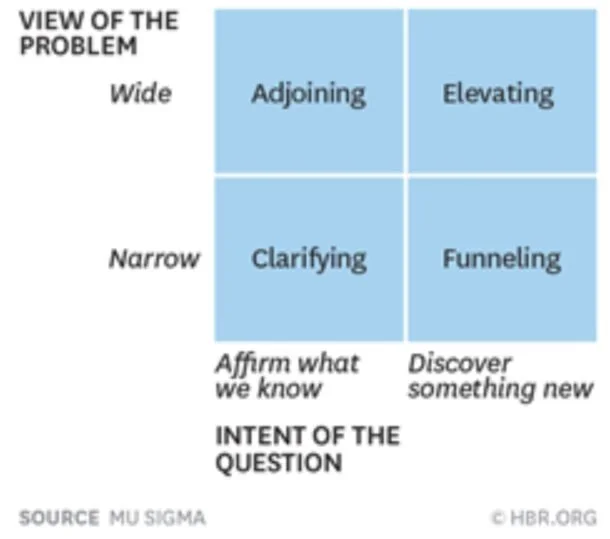The power of the question mark
"In changing environments, the big prizes go to those who ask better questions and learn faster. In organizations, this comes down to leaders teaching and coaching others to think more strategically and ask deeper questions. If you think like everyone else, you are likely to be average. The best strategic thinkers, leaders and entrepreneurs distinguish themselves by how they frame decisions, the kinds of questions they ask and their mode of inquiry.”
This is how MIT Sloan summarises what leaders need to do in its article The Power of Asking Pivotal Questions. At SWOOP Analytics we examine interaction patterns between people on enterprise social networks Yammer by Microsoft and Workplace by Facebook. One of the things I have always wanted to uncover is how many questions are being asked, and what – if any – impact is made by asking questions.
About six months ago we started to investigate if we could detect if a question was being asked by searching for a question mark. To test this, we manually trawled through more than 1,000 messages posted on our own company enterprise social network. Our assumption proved correct. There were a few exceptions, for example, people posting links to webpages that included a question mark in the URL. Similarly, a very small proportion of posts with question marks were rhetorical questions not needing an answer and in other cases a person was asking a question but without using a question mark. However, all of these were outliers, so we felt confident that our ‘rough and ready’ approach of searching for questions marks would be a reliable way to determine the extent to which people ask questions.
From the initial 1,000 messages we expanded the study to include messages from three different or organisations, and we decided to analyse about six months of data which totalled just over 123,000 messages. The sample included one Workplace instance (Organisation B) and two Yammer networks (Organisation A and C). Organisations A and B have previously performed well in our global benchmarking studies, whereas Organisation C benchmarked as average.
The proportion of messages with questions across the three organisations was surprisingly similar ranging from 10% - 12%:
Given the volume of data we’ve analysed, and the results from the three organisations were very similar, we can’t think of a reason why the above ratios wouldn’t apply to other organisations. We suggest that it is reasonable to put forward a “10% of messages are questions” rule of thumb for enterprise social networks.
Are threads longer when you ask questions?
We expected exchanges between people would continue for longer if the original post or subsequent replies included a question. However, we didn’t really have a sense of how much a question would impact the length of a thread, and the very substantial difference has come as a surprise. For threads where no one asks a question, the number of messages averaged 1.8 – 2.0 messages but the threads that included questions ranged from 4.5 – 5.5 messages.
In summary, when you ask questions the threads are 2.5 times longer than if you don’t. Asking a question is therefore an exceptionally powerful way to elicit conversation and engagement. Given 90 per cent of messages do not include any questions, there seems to be ample opportunity to ask more questions.
Do groups differ?
Groups are the engine room for collaboration and groups are an effective way to focus conversations around a topic. Therefore, we thought it would be interesting to see if groups differ in terms of members asking questions. A minimum threshold of 50 messages for a group was applied to avoid the risk of a small number of messages in a group interfering with a percentage-based comparison of groups.
We found all three organisations had groups that didn’t ask questions at all. But the upper limit was quite different, ranging from 25% - 42%.
We also checked to see if groups would be asking relatively more questions the larger they got, but we found no such correlation:
What would be interesting though would be to consider what type of groups are asking lots of questions (e.g. surpassing the average 10%), and which ones aren't. You would expect that a Q&A group would have a higher proportion than an information sharing group, and if there is a mismatch between the group's purpose and its propensity to ask questions then an intervention is required.
Do people differ?
Questions are obviously asked by people, so the final thing we wanted to explore was if the same level of variety we had found for groups could also be found for individuals. We applied a minimum threshold of 50 messages for a person to be included in the analysis.The results were similar to what we found for groups:
A small proportion asks no questions at all and the top ranged from 36% - 42%. Given employee engagement is high on the list of many leaders, there seems to be a great opportunity to ensure that leaders are prompted to maintain an appropriate balance between ‘telling’ and ‘asking’.
What questions could you ask? The 2015 Harvard Business Review article Relearning the Art of Asking Questions provides a useful framework for consideration, which included examples questions of each category is provided below:
HBR Question Category
Adjoining:
How would this concept apply in a different context?
What are the related uses of this technology?
Elevating
Taking a step back, what are the larger issues?
Are we even addressing the right question?
Clarifying
Can you tell me more?
Why do you say so?
Funneling
How did you do the analysis?
Why did you not include this step?
The above questions are a great example of how you can engage with colleagues by asking questions. But it is also possible for leaders to use questions as a way to initiate conversation.
Take for example Bill Morrow, CEO of NBN Co, an Australian organisation with some 7,500 employees. Mr Morrow wanted to shift his online engagement style from ‘telling’ to ‘asking’, and kicked this off by posting the message below on NBN’s enterprise social network.
This single post received more than 200 replies highlighting the power of the humble question mark.
We hope we’ve inspired you to consider asking more questions to drive deeper conversation and engagement. What question will you be asking?

















